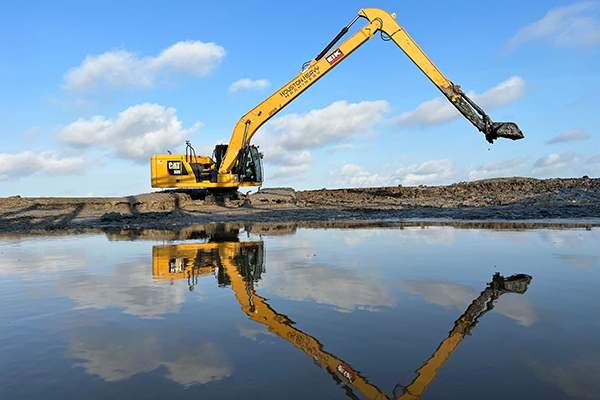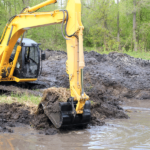In places where the ground turns to mush and water refuses to step aside, conventional construction equipment fails. Enter the amphibious excavator—a brilliant mix of buoyancy and brute force. These specialized machines can float, dig, and travel through marshes, swamps, and other aquatic environments where typical machinery would sink or stall. From flood response efforts in Southeast Asia to marshland restoration projects in the United States, amphibious excavators are becoming essential tools in wetland engineering.
The Anatomy of an Amphibious Excavator
Key Components That Make It Work
- Floating Pontoons: Made from high-tensile steel or aluminum, they provide buoyancy and help prevent sinking.
- Spud Anchors: These are hydraulic poles that stabilize the machine in water while digging.
- Hydraulic Long Arms: Extended booms allow for deeper reach without repositioning the base.
- Reinforced Undercarriage: Strong enough to bear the weight of both machine and operator in shifting terrain.
Together, these components allow the excavator to perform in shallow rivers, coastal areas, swamps, and flood zones with ease.
Applications: Where Do Amphibious Excavators Work Best?
1. Wetland Restoration Projects
Wetlands are often inaccessible by road or standard equipment. Amphibious excavators help restore natural habitats by clearing invasive species, rechanneling waterways, and planting native vegetation—all without disturbing the delicate soil.
2. Flood Management and Disaster Response
These machines are often used after hurricanes or floods to clear debris, rebuild levees, and dredge rivers. Their ability to move through waterlogged terrain makes them ideal for quick recovery operations.
3. Dredging Operations
From coastal dredging to canal cleaning, amphibious excavators remove sediment buildup that can block water flow, ensuring water transport and irrigation systems remain functional.
Environmental Impact: Gentle Giants in Fragile Ecosystems
Why They’re Better for Wetlands
Unlike bulldozers or standard tracked excavators, amphibious excavators:
- Distribute weight over pontoons, reducing ground pressure and minimizing soil compaction.
- Preserve natural water flow and sediment layers.
- Operate with lower noise and emissions, especially newer electric or hybrid models.
This makes them ideal for sensitive ecosystems like mangroves, bird sanctuaries, and marshlands, where traditional construction might cause long-term ecological damage.
Flood Control and Climate Resilience
A Response to Rising Waters
With climate change leading to more intense storms and rising sea levels, amphibious excavators have become part of global flood defense systems. They assist in:
- Building storm barriers
- Reinforcing levees
- Dredging clogged urban canals
- Removing silt from floodplains
Their ability to move quickly between land and water makes them valuable in both proactive (infrastructure prep) and reactive (emergency cleanup) situations.
Technology Behind the Machine: Smarter, Greener, Stronger
GPS Integration and Remote Control
Modern amphibious excavators can be equipped with GPS and sonar systems to ensure precision dredging or wetland grading. Some models also offer remote-control operation, reducing risks for human workers in unstable areas.
Fuel Efficiency and Hybrid Models
Manufacturers are now producing hybrid or fully electric amphibious excavators to reduce carbon footprints, especially important in protected natural areas.
Global Use Cases: Amphibious Excavators in Action
United States: Mississippi River Delta Restoration
In Louisiana, these machines help restore eroding marshlands by building terraces and planting vegetation to slow coastal erosion.
Netherlands: Floodplain Dredging
The Dutch use amphibious equipment to maintain their extensive network of dykes and canals, ensuring urban areas stay dry during heavy rainfall.
Bangladesh: Post-Monsoon Rehabilitation
During and after monsoon seasons, Bangladesh deploys amphibious excavators to clear silt, repair embankments, and reopen waterways crucial for rural transport.
Indonesia: Mangrove Forest Conservation
Indonesia uses them to remove debris and plastic waste from mangrove forests without disturbing tree roots, boosting both ecological health and tourism potential.
Conclusion: Floating Into the Future of Sustainable Construction
The amphibious excavator isn’t just a marvel of engineering—it’s a symbol of how technology is adapting to Earth’s most complex challenges. Whether it’s restoring fragile wetlands, preventing floods, or supporting post-disaster cleanup, this machine proves that digging deep and thinking ahead can go hand in hand.
In a world where the line between land and water is constantly shifting, amphibious excavators are helping humanity stay one step ahead—safely, sustainably, and smartly.
FAQs
1. Can amphibious excavators work in deep water?
Most amphibious excavators are designed for shallow waters up to a few meters deep. For deeper water tasks, they can be equipped with spud stabilizers or paired with floating platforms.
2. What industries use amphibious excavators the most?
Industries like construction, disaster management, oil & gas, wetland conservation, and agriculture rely heavily on these machines in environments where both water and soft terrain are present.
3. Are amphibious excavators expensive to maintain?
Maintenance costs are generally higher than standard excavators due to specialized parts and the need for corrosion-resistant components, especially in saltwater environments.
4. Can amphibious excavators be rented?
Yes, many equipment rental companies now offer amphibious excavators for rent, especially in regions prone to flooding or wetlands-based construction.

















